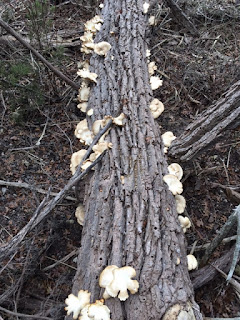Osage orange, bois d'arc, hedgeapple, monkey brains...this fruit and tree have so many different names. Most of us have seen these large green balls sitting in the grass in the fall.
 |
| Hedgeapples or Osage Oranges |
These trees really stand out because the wood has an orange hue to it.
 |
| Bois D'arc or Osage Orange Tree |
I grew up calling the fruit "horse apples" and while I always had a
good time kicking and throwing them around I never gave them much
thought.
A long time ago I saw a post on Eat The Weeds about
this fruit where I learned it was edible, at least part of it.
http://www.eattheweeds.com/maclura-pomifera-the-edible-inedible-2/
Later, I watched an episode of Weird Fruit Explorer where Jared
painstakingly extracts and cooks the seeds of an Osage Orange.
https://www.youtube.com/watch?v=40U8F8ZD9f0&vl=en
I thought it was interesting but I wasn't too tempted to give it a go
myself until I saw yet another mention of the fruit on Foraging Texas.
https://www.foragingtexas.com/ (I can't retrieve the specific entry on Osage Orange so you will have to dig for it)
After finding three separate mentions of this fruit and I knew I
had to try it. Last year I gathered some and tried to process them. It
didn't go well. To deal with the sticky latex inside the
fruit I had read that a couple rounds of freezing and thawing would
help tame it and make the seeds more accessible. Unfortunately I was a
bit too aggressive in my freeze/thaw cycles and ended up with a stinky
pile of goo. This year I decided to try it again and the results were
much better. I froze the fruit, thawed it, froze it again, and then let
it thaw. This time the fruit was soft but intact and I was able to
separate all of the seeds fruit the flesh with oiled hands. After
collection, the seeds soaked in several change of until I thought all the latex was gone. I air dried the seeds on a paper towel and then I roasted them with oil and salt until they started to
pop. The seeds on the LEFT are from this first experiment.
 |
| Two batches of roasted seeds |
Because of my successful first batch, I tried it again with another Osage Orange from a completely different location. This one was a larger and older/riper than the first. I processed it exactly the same way except I dried them in a dehydrator before I roasted them with oil and salt. I don't know if it is because of my method, trees in different locations, or the age of the fruit but I think the second batch on the RIGHT came out much better. Also, this batch had fewer "hairs" than the last. I found two more Osage Oranges in a third location and when I have time I will be processing the seeds one more time just to see if method, location, or age really have anything to do with the final product.
 |
| Roasted seeds in a jar for storage |
So...how do they taste? Good. Not great, but definitely good. Others have compared them to popcorn and pine nuts and I can definitely see that but to me they taste almost exactly like roasted acorn squash seeds- nutty with a hint of bitterness. They would be nice mixed with a blend of other seeds as a salad topping or an embellishment for trail mix. Is it worth it? I don't know. I enjoyed learning how to process the seeds and while the final product was edible and arguably tasty, the yield was very low and the amount of time and work required to get these little morsels was ridiculous.



























